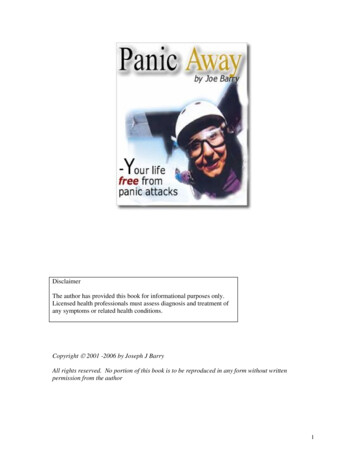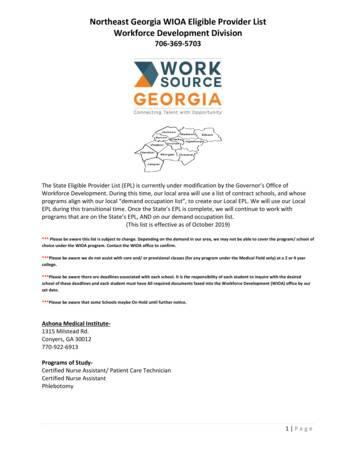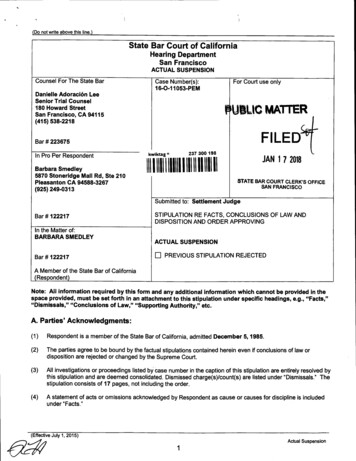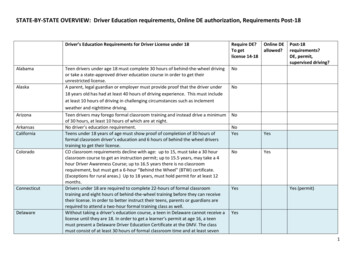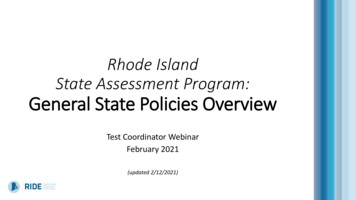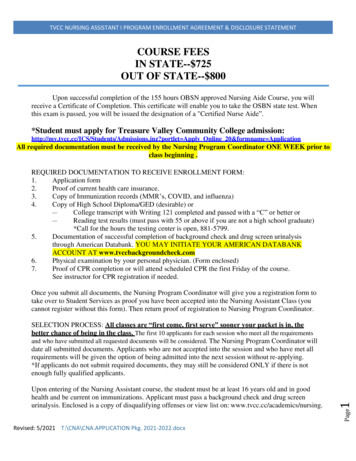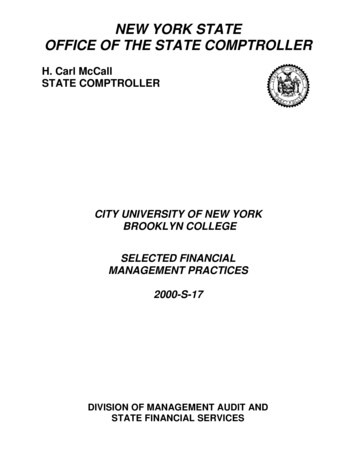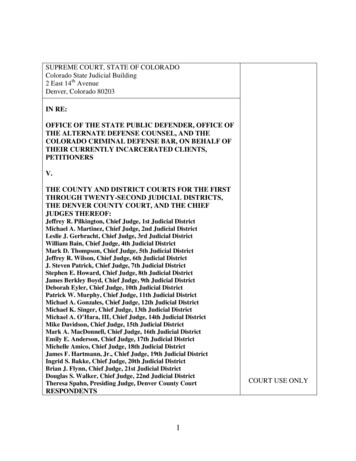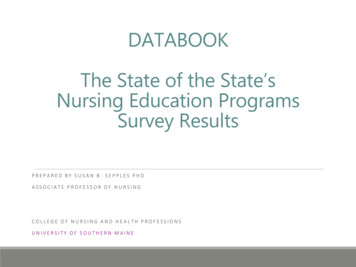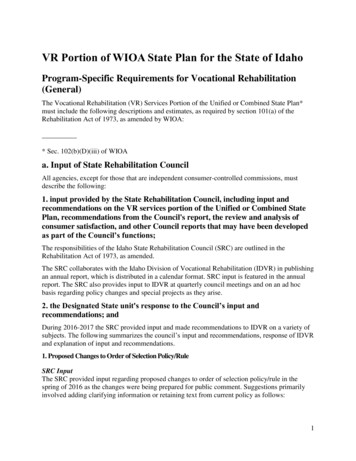
Transcription
VR Portion of WIOA State Plan for the State of IdahoProgram-Specific Requirements for Vocational Rehabilitation(General)The Vocational Rehabilitation (VR) Services Portion of the Unified or Combined State Plan*must include the following descriptions and estimates, as required by section 101(a) of theRehabilitation Act of 1973, as amended by WIOA:* Sec. 102(b)(D)(iii) of WIOAa. Input of State Rehabilitation CouncilAll agencies, except for those that are independent consumer-controlled commissions, mustdescribe the following:1. input provided by the State Rehabilitation Council, including input andrecommendations on the VR services portion of the Unified or Combined StatePlan, recommendations from the Council's report, the review and analysis ofconsumer satisfaction, and other Council reports that may have been developedas part of the Council’s functions;The responsibilities of the Idaho State Rehabilitation Council (SRC) are outlined in theRehabilitation Act of 1973, as amended.The SRC collaborates with the Idaho Division of Vocational Rehabilitation (IDVR) in publishingan annual report, which is distributed in a calendar format. SRC input is featured in the annualreport. The SRC also provides input to IDVR at quarterly council meetings and on an ad hocbasis regarding policy changes and special projects as they arise.2. the Designated State unit's response to the Council’s input andrecommendations; andDuring 2016-2017 the SRC provided input and made recommendations to IDVR on a variety ofsubjects. The following summarizes the council’s input and recommendations, response of IDVRand explanation of input and recommendations.1. Proposed Changes to Order of Selection Policy/RuleSRC InputThe SRC provided input regarding proposed changes to order of selection policy/rule in thespring of 2016 as the changes were being prepared for public comment. Suggestions primarilyinvolved adding clarifying information or retaining text from current policy as follows:1
The SRC suggested that Administrative Requirements Section 14.3 retain informationregarding funding arrangements such as the impact of order of selection on third partyagreements, given the increased contracting and pilot projects that IDVR is movingtowards, especially with pre-employment transition services (Pre-ETS).A suggestion was made to expand the Reassessment of Severity of Disability Section14.4 to provide more procedural guidance on how the customer makes the request, forexample, what the role of the vocational rehabilitation counselor is in the process.Input for the Maintenance of Statewide Order of Selection Waitlist Section 14.4,included:o Adding criteria for the written notification, such as must be written in plainEnglish or the person’s native language for non-English speakers and so thatpeople with developmental disabilities, learning disabilities, or other difficultieswith language can better understand what is meant.o Adding text about the responsibility to notify IDVR in the event of a change incontact information, e.g., address, telephone number, etc., as well as an alternativecontact person who might know the whereabouts of the person should they moveor die.o A request for clarification on the change from 40 days to 30 days for the customerto respond.o Expanding information on how a customer can retain their place on the waitlistshould they be unable to act on employment services at the time their name comesup on the waitlist.For the Information and Referral (I&R) Section 14.5, clarify the process for release ofinformation during referral to another state or federal state program.With the removal of information from the procedure manual regarding counseling andguidance, the SRC suggested strengthening the proposed text to better help counselorsunderstand the parameters for engaging in this.IDVR ResponseIDVR added a statement regarding funding arrangements back into the AdministrativeRequirements section of the policy and expanded the section on Reassessment of Severity ofDisability. IDVR also incorporated the recommendation for plain English language.IDVR added text regarding the responsibility for the customer to update contact information andrespond to the agency contact within 30 days. Additional information was also included toclarify the process for customers to retain placement on the waitlist.IDVR felt that customer confidentiality protocols apply throughout the rehabilitation process, butreinforced this with an additional reminder of this in the I&R section of the OOS policy. IDVRalso felt the proposed policy adequately described the type of information, guidance, and referralservices staff are required to provide to customers, along with the documentation requirements.To strengthen understanding of the policy, however, the Division plans to providecomprehensive training regarding OOS, along with additional fact sheets to help staff andcustomers understand the process and requirements.2. IDAPA 47.01.01, VR Rules and IDVR Field Services Policy Manual2
SRC InputA draft notice of rulemaking was presented at the SRC’s May 4, 2017 meeting where memberswere requested to provide input on three policy changes to comply with WIOA involving: Supported Employment Pre-Employment Transition Services Services to Individuals who are Seeking Employment at Subminimum WageA variety of questions from council members were answered by IDVR staff following thepresentation. An additional comment below was sent by email following the meeting:Section 12.17.3 - Auxiliary Aides or Services Necessary to Support Pre-Employment TransitionServices: There is a reference that VR will pay for the service if no other entity is REQUIREDto provide such an aid or service. Is this referencing services required under IDEA? Is thisreferencing other services such as habilitative intervention or IBI services that may providebehavior management supports that would enable a student to participate in pre-ETS? Wouldthese be considered required or provided by VR?IDVR ResponseIDVR agrees that the use of the word “required” should be changed to “customarily” and that thedefinition did not clearly explain what auxiliary aides or services are, therefore, IDVR ischanging the language to the following: “If a student with a disability, including potentiallyeligible students, requires an auxiliary aid or service, e.g., interpreter, reader services, oraccessible informational materials, to access or participate in pre-employment transition services,VR may pay for the service, if not customarily provided by another entity, including localeducational agencies. Auxiliary aides and services are those services necessary to ensure equalaccess to pre-employment transition services, as required by the Americans with Disabilities Actof 1990 (ADA), as revised by the ADA Amendments Act of 2008, and Section 504 of theRehabilitation Act.”3. Qualified Hearing OfficersSRC InputThe SRC assisted IDVR in identifying qualified hearing officers who have an understanding ofor have the ability to understand the nature of the Rehabilitation Act as amended, state andfederal regulations pertaining to the provision of VR services, and the policies and proceduresdeveloped and maintained by the state.IDVR ResponseIDVR agreed with the input from the SRC regarding qualified hearing officers and incorporatedit in the selection process.4. Transfer of FundsSRC InputSRC member input was provided to IDVR concerning the agency’s intent to utilize transferfunds from the Extended Employment Services (EES) program to the VR program for matchpurposes.3
IDVR ResponseThe state Controller’s Office subsequently informed IDVR that the funds source must be fromthe same fund source, i.e., General State funds to General State funds. Because of the timinginvolved, IDVR decided not to attempt the transfer because it could not be completed prior to theend of the state fiscal year.5. Quarterly Status ReportSRC InputIDVR provides quarterly status updates to the SRC on the progress the Division is makingrelated to performance indicators as well as the goals and priorities for the Division. The SRCcommented on drafts of the update at several council meetings in 2017. Some of the informationIDVR will be reporting on is new under WIOA, for example, common performance measures,and will be populated over time as data becomes available.IDVR ResponseIDVR has modified and streamlined the quarterly update report to include the current commonperformance measures and will incorporate the new goals and priorities, based on the recentCSNA, developed in collaboration with the SRC for a more comprehensive product. The SRCwill continue to be asked for input on these as well as any additional indicators that might behelpful in the report. The end product of these quarterly status revisions will be a quarterlyreport to the SRC that is based on SRC WIOA related goals and priorities that includes quarterlyupdates on WIOA mandatory primary performance indicators.6. Comprehensive Statewide Needs Assessment (CSNA) Survey QuestionsSRC InputMuch of the SRC’s input regarding survey questions targeted to individuals involvedrecommendations aimed at gathering additional information on the customer’s needs relating toemployment goals, especially the need to include examples that help the responder better focusanswers to questions. A companion suggestion was to use more of a plain language approach forterms or jargon (i.e. means-tested, assistive technology, disability-related personal care, primarydisabling condition etc). The SRC suggested additional questions to gain more feedback onIDVR services as well as a more complete description of the relationship with American JobCenters and other WIOA partners. Suggestions were also made to expand the reach of the surveyto potential VR participants.In the survey to staff, the SRC made suggestions for expanding questions concerning internalprocesses and staff demographics. Also, to restructure questions for greater consistency, reformatsections to reduce redundancy, and regroup categories to gather additional information on clientpopulations and subcategories within those populations.Similar to the staff survey, the SRC suggested changes in the survey to community partners thatmight help increase consistency, lessen redundancy and gather more information on categories ofclient populations.4
For the survey to businesses, the SRC suggested an enhanced focus on identifying gaps that existbetween VR and employers, including general awareness of VR. In addition, to include examplesas a way to help explain terms that might not be familiar to businesses.The SRC also made general suggestions on how the survey could be expanded for informationon related services that impact individuals with the most significant disabilities, to integrate thesurvey results with those of focus groups and program data, and how the elements of the needsassessment could further drive development of IDVR’s goals and objectives.IDVR ResponseIDVR agreed with the SRC’s comments and forwarded suggestions for revision to SDSU’sCSNA coordinator: The SRC’s comments and input were forwarded to the survey developers atSan Diego State University and most were subsequently incorporated into the four surveysdistributed during November-December 2016, while others were used with focus groups in 2017.IDVR will retain these comments to inform the development of its next CSNA which is due tobe conducted in PY 2019.7. CSNA Report Developed by San Diego State UniversitySRC InputThe SRC suggested revisions affecting the structure and formatting of the report as well asnumerous typographical/grammar changes. As examples, below are two of the suggestions:In Appendix C: Idaho Regional Demographics, all the work done to collect the data isappreciated, but not sure how it relates to the CSNA unless there is a tie to this in another part ofthe report. Is there a place where the outcomes achieved by IDVR customers is compared to thedata in this appendix? Or, where IDVR resources are tied to the population centersdescribed? Or, where jobs secured by IDVR customers relate to the industries described?IDVR ResponseIDVR believes Appendix C provides necessary information by which to understand thedemographics of the state. It serves as a reference point to better understand the trends in thestate’s population, prevalence of disabilities in the state, labor force participation andunemployment rates and information on the number of students and youth in the state. Thisinformation helps determine whether the agency is providing services to the appropriate targetpopulation(s).SRC InputNot sure why Appendix D, which involved Extended Employment Service (EES) rates, wasincluded in the CSNA since EES is not an IDVR service that falls under the purview of theSRC. If there is a purpose, this should be called out.IDVR ResponseIDVR agrees with the SRC and removed this Appendix from the final report.SRC Input5
The SRC also gave input on potential issues for consideration in the IDVR portion of theCombined State Plan and the IDVR Strategic Plan based on findings of the CSNA, such as:Access to VR services – transportation is called out as a major barrier; is there a strategy that canbe implemented to take VR to the community vs. having the individual have to come to VR toaccess services? It is called out that growth in rural areas will outpace non-rural areas; does VRneed to look at how to address the needs of a more rural population? Is there value in trackingwhere people reside in the state and set rural goals to ensure this population is served? It isinteresting that it is the provider and VR staff that rank transportation as a major barrier toaccessing services and customers do not rank this at the same level.IDVR ResponseThe Division recognizes that the lack of adequate public transportation is a major concern andcreates a barrier to accessing services in the state. The Division cannot address this issue inisolation. The Division is committed to participating as a member of the TransportationInitiative. Additionally, IDVR provides services in the community, either on a full time oritinerate basis, collaboratively with agencies such as Department of Corrections, JuvenileCorrections, Behavioral Health, and within schools. IDVR also provides services at local onestop facilities. IDVR may need to further evaluate other ways in which to deliver services tothose in rural areas, however transportation is a common issue across multiple core WIOApartners, and may be better addressed at the Combined State Plan level rather than VR specificportion of the WIOA plan level.SRC InputNot necessarily tied specifically to rural areas, but the CSNA indicates lack of information aboutservices and difficulties scheduling meetings with counselors as the two most common barrierssited by customers. These are both within in IDVR’s control. Is there a strategy to address thesebarriers?IDVR ResponseIDVR does note that Table 13 from the CSNA reflects customer perception on individualbarriers to accessing IDVR services, however the Division needs more information around howthese barriers are perceived by customers to determine if there are common themes reflected bythese responses, or if people are interpreting these items in a variety of ways. The Division willwork to better understand what is meant by “Lack of information about services” and“Difficulties scheduling meetings with your counselor” prior to developing a strategy to addressthese barriers, and has added this item to IDVR’s 4-year work plan.SRC InputQuality of services provided by Community Rehabilitation Providers (CRP) – consistent qualityservice provision is called out as lacking across providers; is there a strategy that can bedeveloped to assess and potentially improve the quality of CRP services? There is reference toparticipants perceiving there is a lack of a variety of options for employment in Idaho and thatCRP’s are repeatedly approaching a limited number of employers, which impacts the options.Are there strategies that can be implemented to increase the options or, at least, identify whatoptions are being accessed? If so, how does this compare to the labor market in general?6
IDVR ResponseThe Division recognizes this as an important issue and thusly included it as a priority, asreflected in Goal 2, Priority 7 - Collaborate with Community Rehabilitation Program partners toimprove the quality of services.SRC InputThe work done by IDVR EES on rate study was called out as a way of understanding issuesrelated to quality and consistency of services; is there value in looking at doing somethingsimilar for 110 services?IDVR ResponseThis was removed from the CSNA by request of the SRC.SRC InputReference is made that IDVR is creating programs that are national models that will meet theneeds of individuals with disabilities; however, these specific programs are not called out in theCSNA report. What are these models and will expansion of these models need to be included inthe State Plan?IDVR ResponseThe models are mentioned by SDSU referenced the Customized Employment (CE) Pilot Projectand process requirements for Section 511 Subminimum Wage Employment. CustomizedEmployment is incorporated into the Goals and Priorities section of the VR Services Portion ofthe State Plan under Goal 1, Priority 2. The Division has developed the process and policy tomeet the requirements of Section 511.SRC InputIDVR is spending over 2000 per case that is closed unsuccessfully. What can be done toexplore ways to reduce unsuccessful case closures and applying the limited resources VR has tothe desired outcome of employment?IDVR ResponseIDVR intends to better understand our customer expenditures by conducting an assessment ofexpenditures as identified in Goal 2, Priority 5 of the VR Services Portion of the State Plan.SRC InputThroughout the report, there is reference to most significant disability, significant disability anddisability. Most significant disability does not appear to be defined in the document, so we donot know what definition our survey respondents based their responses on. Is “disability” apopulation or is there value in looking at more specific disability types to see if there areunderserved or un-served subgroups? For example, evaluating the findings mostly from an“autism parent” or “autism advocate” lens, some observations stand out: In the most significant disability cases of autism, individuals themselves can rarelyrespond effectively; they need to rely on someone else (usually a family member or other7
willing caregiver) to respond on their behalf , so that a non-expert counselor orVocational Rehabilitation “assessor” gets an interpretation of needs and/or skills.If WIOA guides us to prioritize candidates with most significant disabilities, it does notappear that the current findings tell us what we need to do to get more msd groupsgainfully employed.Not specifying the various functional impairments for a “spectrum disability” like autismprevents this needs assessment from being more helpful for assessing a candidate’s needsand employment options more specifically, which includes aligning them witha knowledgeable provider “counselor” who knows how to help an individual with autismovercome or mitigate his disability(ies).o For example, hypothetically, our Vocational Rehabilitation program is able to putpeople with autism—who have social communication deficits—into employmentoptions today via a,b, c means. People with autism—who have no/minimalcommunication and/or disabling behaviors at times—can (in the future) be placedin a “Customized Employment” track.IDVR ResponseIDVR agrees that an explanation of severity of disability i.e., most significant disability, severedisability, and disability would help the reader understand these terms. A paragraph was addedexplaining these terms in ‘Section 2 – Needs of Individuals with the Most
The responsibilities of the Idaho State Rehabilitation Council (SRC) are outlined in the Rehabilitation Act of 1973, as amended. . referencing other services such as habilitative intervention or IBI services that may provide behavior management supports that would enable a student to

